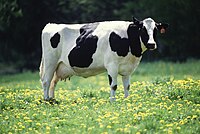
Photo from wikipedia
The concentration ( c) of free fatty acids (FFAs) in milk is an indicator of dairy cow nutrition, milk straining, its bacterial contamination and storage quality. High FFA concentrations (… Click to show full abstract
The concentration ( c) of free fatty acids (FFAs) in milk is an indicator of dairy cow nutrition, milk straining, its bacterial contamination and storage quality. High FFA concentrations ( cs) caused by lipolysis can damage the quality properties of milk products. Therefore the FFA content is introduced thanks to an increase in the efficiency of modern analytical methods as a milk quality indicator and as an indicator for its price as well. The goal of this paper was to analyse the FFA relations to the other milk quality indicators. The data set ( n = 11 586) was evaluated by regression methods. In November and December the respective FFA means were 0.614 ± 0.458 and 0.835 ± 0.491 mmol/100 g with a relatively high variability of 74.6 and 58.8%. The frequency of unsatisfactory FFA values (> 1.3) was 7.51 and 13.93%. Casein content ( r = -0.17; P < 0.01) and crude protein content ( r = -0.12; P < 0.01) were related more closely with FFA c. The FFAs can increase by 0.066 mmol/100 g with casein decrease by 0.10%. The FFAs in milk fat can slightly increase by the supply of energy to dairy cows (protein and casein decrease) and rise with the deteriorating health state of mammary gland (lactose, r = -0.14; P < 0.01) as well. The somatic cell count correlated with FFAs more weakly ( r = 0.07; P < 0.05), similarly like the total mesophilic bac - teria count ( r = 0.11; P < 0.01), relatively more closely the psychrotrophic bacteria count ( r = 0.27; P < 0.05). The deterioration of almost all hygienic indicators signified an FFA c increase. The urea content correlated with FFAs weakly ( r = -0.08; P < 0.05) and the fat content imperceptibly as a component of similar substance like FFAs. The mechanical milk stress led to FFA liberation from fat esters proportionally to the intervention intensity ( P < 0.001). Even a relatively small mechanical stress caused by mixing comparable to the current milking technology, milk transport and storage increased the FFA c of milk fat from 1.11 ± 0.19 to 1.80 ± 0.40 mmol/100 g (P < 0.05). The highest experimental stress up to 6.88 ± 0.55 mmol/100 g ( P < 0.001).
Journal Title: Czech Journal of Animal Science
Year Published: 2018
Link to full text (if available)
Share on Social Media: Sign Up to like & get
recommendations!